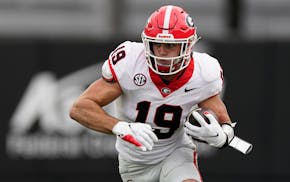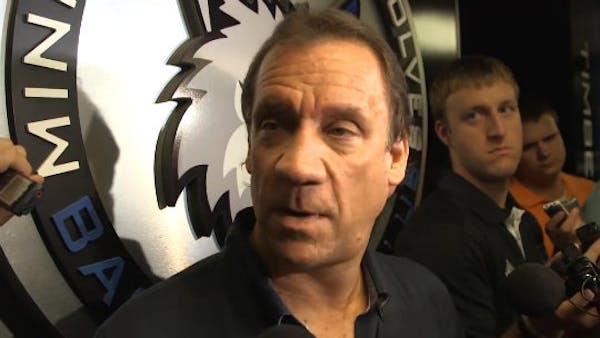When Richard Pitino recruits players, there are three letters he hears more than any single word.
N.B.A.
"It really is what it's all about," the 31-year-old Gophers coach said. "They come to Minnesota or any other Big Ten school with aspirations of playing in the NBA. That's probably their first goal."
The coach, coming up on his second season, does not yet have a track record at the U to show them.
The same goes for his school, at least as far as teenagers are concerned.
Thursday's NBA draft is expected to be the 10th consecutive that ends with not one former Gopher called.
Among 14 Big Ten teams — including Maryland and Rutgers, which officially join the conference July 1 — only Northwestern, Nebraska and Penn State have longer droughts.
"There is a problem with that," said Richard Coffey, who played for Minnesota from 1986 to 1990 and whose son, Amir, is a star at Hopkins and a 2016 recruit considering the Gophers. "You're [in] one of the best conferences in the nation, you should have the ability to somewhat attract those kids."
The gap is unprecedented in Minnesota history. Since 1957, the Gophers have had 43 players taken in the NBA draft — a total that ranks eighth among Big Ten teams, behind Ohio State and Iowa, with 44 each, and ahead of Wisconsin, with 28. Before 2004, the Gophers had gone no longer than five years without a player drafted.
But after forward Kris Humphries (now with Boston) was taken 14th overall by Utah in 2004, the steady train halted.
Those surrounding the program say Minnesota's run of insufficient recruiting and an inability to develop talent is at the root.
A lack of big victories isn't helping the cause either. In this 10-year span, the Gophers have finished higher than sixth in the conference just once (tied for fourth, 2004-05), and have won only one NCAA tournament game.
"The players haven't been good enough," said Flip Saunders, the Timberwolves coach and director of basketball operations, and former Gophers guard. "Bottom line is that they've kind of been on the edge. The last few years, they really haven't had what you'd call a marquee, top-line all-conference type player."
Smith's style to blame?
Saunders noted that the style of former coach Tubby Smith, who after six years was fired following the 2012-13 season, was not particularly conducive to driving talent to the next level.
"He believed more in the team concept than individuals, so it didn't really promote those types of players," Saunders said.
The Gophers can count quite a collection of one-time players in his tenure who were initially thought to possess great NBA potential.
Rodney Williams (2009-13) was projected by many as a lottery pick when he arrived on campus, but his draft stock tumbled dramatically over four years under Smith.
Trevor Mbakwe (2010-13) had the big body and promise, but his college career was continually interrupted by knee injuries and legal issues.
Royce White and Colton Iverson both had their names called at an NBA draft, but their college careers did not end in Dinkytown. White never played a minute in maroon and gold, leaving for Iowa State after a suspension for off-court incidents. He was drafted 16th in 2012 by Houston. Last year, Iverson (2008-2011) was drafted in the second round by Indiana, something that might not have happened if he hadn't transferred to Colorado State for a successful final season.
Iverson's onetime frontcourt mate Ralph Sampson III (2008-2012) also arrived with great expectations, but he too seemed to regress instead of improve under Smith.
Changing the trend
Former Gopher Kevin Lynch (1987-91) noted that his coach, Clem Haskins, was critical in motivating and physically pushing him to max out his talent.
"You have to develop players," said Lynch, who was selected in the 1991 second round and played briefly for Charlotte.
"If you're Minnesota … you're just not going to get [big recruits] like Humphries — that's unusual. [Developing players] is how you have to do it if you're going to send guys to the draft."
With similar goals in mind, Pitino sets aside time for "individual instruction" each practice. Players will come in for about 40 minutes in the morning before working on team aspects in the afternoon.
"I tell them, 'Individual instruction is your time to get better, it's your time to work on being a pro. Be selfish during this workout. It's all about you.'
"We all understand … that we're not going to be able to recruit ready-made pros right away just yet at this stage of our program. So my goal would be every guy that we bring in has got tremendous upside. As we move forward with our recruiting classes, it's going to be a lot of untapped potential and now it's our job to really develop them."
Coffey said as a father of an elite recruit, the three things he and his son are looking for in a program are how it fares in its conference, whether it reaches the NCAA tournament consistently and whether it's feeding its players to the NBA.
In the past 10 years, the Gophers have put up lackluster grades in all three categories, but Coffey hopes that change is on the horizon.
"The pedigree of Pitino and the success of his father [Louisville coach Rick Pitino], he should definitely know what it takes," he said.
If, as expected, Austin Hollins, the only Gophers player on the draft radar, doesn't hear his name called on Thursday night, at least one of those three trends will continue for another year.
Olympic sports bodies criticize track and field's move to pay $50,000 for Paris gold medalists
Soldiers who lost limbs in Gaza fighting are finding healing on Israel's amputee soccer team
Minnesota state parks press on with camping reservation system tweaks

